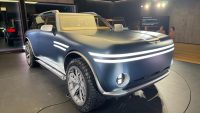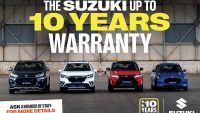 ONE of THE coolest cars of the late 1980s was Honda’s ballistic CR-X.
ONE of THE coolest cars of the late 1980s was Honda’s ballistic CR-X.
Short, squat and stubby, it was a road-going missile when fitted with the mesmerising 1.6-litre VTEC engine, famed stratospheric rev limit ‘n all. This model, more than any other, cemented the VTEC legend in Honda’s history.
Now, the brand is hoping to repeat this trick, but using different technology. Enter the CR-Z: a short(ish), stubby and squat coupe, fitted with an even more hi-tech drivetrain. Yup, it’s the CR-Z IMA hybrid – Honda’s take on the coupe of the future.
On looks alone the new Honda CR-Z demolishes the viewpoint hybrids can only be joyless transportation modules for those who put eco posturing before driving pleasure. This is a great looking car – sleek, sexy and distinctively futuristic. The cues to the CR-X are clear and intentional; it’s distinctive in its own right – and anything but ‘eco’ in appearance.
Mind you, it’s not quite a full-on Prius-style hybrid mechanically, either. Instead, the ‘mild hybrid’ concept uses a 1.5-litre high-efficiency petrol, that’s ‘assisted’ by an electric motor. Yup, that’s the ‘Integrated Motor Assist’ part; Honda’s thinking is that electric power provides the boost of a larger engine when needed, while the efficient engine sips fuel at a much-reduced rate when not. It can’t, however, offer running solely under electric power.
On the road, it feels strong and flexible as a result, the 9.9s 0-60mph and 124mph making it sound slower than it feels at the wheel. Sure, it’s no rocket ship. But what power there is can be easily exploited. Even better – and a first for a hybrid – it’s got a six-speed manual gearbox! This being a Honda, it’s typically light and positive in action.
Through the corners, it’s fun to drive, as there’s a level of interaction not normally found in hybrids. It’s not necessarily overtly fast or sporty, but the steering is well weighted and responsive, making it ideally suited to urban driving. Here, the car’s compact size, fast-reacting start-stop system and low-down torque make it nippy and frugal in equal measure.
It even rides pretty well too, the extra weight of the battery pack in the rear giving it a planted feel even if the actual kerb weight is a relatively modest 1,147kg.
Where it does strongly copy the CR-X is inside; forget 2+2 claims – the CR-Z is really only a two-seater and most of the time you’ll simply keep the seats flat and enjoy the extra load space.
 The instruments focus on economy. The 3D-layered speedo and rev counter look great, the green glow gradually going from blue then red as the revs build and economy falls. This is just one of many neat visual clues as to how green, or otherwise, your driving is.
The instruments focus on economy. The 3D-layered speedo and rev counter look great, the green glow gradually going from blue then red as the revs build and economy falls. This is just one of many neat visual clues as to how green, or otherwise, your driving is.
Hi-tech features include a three-mode driving system with normal, sports and eco modes, the latter cutting back throttle response and even tweaking power steering and air-con for maximum efficiency.
So, the big test. Having established the CR-Z is fun and looks cool can it also carry off the green credentials? Well, the scores on the doors are 117g/km CO2 and an official combined consumption figure of 56.5mpg. Somewhere behind the Prius’s 89g/km and 72.4mpg or even the closely related Insight’s 101g/km and 64.2mpg. Driven normally the CR-Z easily scores high 40s mpg though.
Thing is, on paper a Mini Cooper with a comparable 122bhp manages 127g/km and 52.3mpg without the need for fancy hybrid hardware and costs £14,100 against the entry level CR-Z’s £16,999. For all the cutesy eco driving displays and congestion-charge dodging the CR-Z isn’t really that green.
Thus, as an out-and-out eco car the CR-Z fails to entirely convince, despite being congestion charge exempt. It is fun to drive and super cool to look at though and as a snazzy runabout with a difference more than a rival to the Mini and others. Can hybrids be fun? Yes, even if this one doesn’t really work the green agenda.
by DAN TRENT

































